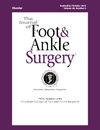Risk factors for screw breakage in Lisfranc joint injuries: A multicenter retrospective study
IF 1.3
4区 医学
Q2 Medicine
引用次数: 0
Abstract
Background
Lisfranc joint injuries are rare but significantly impact foot biomechanics. Open reduction and internal fixation (ORIF) using screws is common, but screw breakage is a frequent issue. While previous studies have reported breakage rates, few have investigated the association between screw type and breakage risk.
Purpose
This study aims to identify risk factors for screw breakage, analyze the timing and patterns of failures, and evaluate their impact on clinical outcomes.
Study design
Multicenter retrospective cohort study.
Methods
This multicenter retrospective study analyzed 233 patients who underwent surgical treatment for Lisfranc injuries at 11 institutions between January 2014 and June 2024. After applying the exclusion criteria, 72 patients were eligible for inclusion in the study. These patients were divided on the basis of screw type (cannulated [n = 31] and solid [n = 41]). Following age- and sex-matching, 48 patients were selected (Group C: cannulated, n = 24; Group S: solid, n = 24).
Results
Screw breakage occurred more frequently in Group C (28.6 %) than in Group S (3.6 %) (p = 0.004). The median time to breakage was 39 weeks (range: 8–54). Logistic regression analysis revealed that usage of cannulated screws was a significant risk factor for breakage (OR 0.132, 95 % CI 0.0252–0.694; p = 0.0167). Despite higher breakage rates, Group C had better final AOFAS scores (median 95.00 vs. 90.00, p = 0.031). Among the 11 broken screws, 7 (63.6 %) were retained without adverse effects on functional outcomes.
Conclusion
Cannulated screws were associated with increased breakage risk in Lisfranc injuries, although this did not negatively impact functional outcomes.
Lisfranc关节损伤螺钉断裂的危险因素:一项多中心回顾性研究。
背景:Lisfranc关节损伤是罕见的,但显著影响足部生物力学。使用螺钉切开复位内固定(ORIF)是常见的,但螺钉断裂是常见的问题。虽然以前的研究报道了断裂率,但很少有人调查螺钉类型和断裂风险之间的关系。目的:本研究旨在确定螺钉断裂的危险因素,分析螺钉断裂的时间和模式,并评估其对临床结果的影响。研究设计:多中心回顾性队列研究。方法:本多中心回顾性研究分析了2014年1月至2024年6月在11家机构接受Lisfranc损伤手术治疗的233例患者。应用排除标准后,72例患者符合纳入研究的条件。这些患者根据螺钉类型分为空心螺钉[n=31]和实螺钉[n=41]。在年龄和性别匹配后,选择48例患者(C组:插管,n=24;S组:固体,n=24)。结果:C组螺钉断裂发生率(28.6%)高于S组(3.6%)(p=0.004)。断裂的中位时间为39周(范围:8-54周)。Logistic回归分析显示,使用空心螺钉是骨折的显著危险因素(OR 0.132, 95% CI 0.0252-0.694;p = 0.0167)。尽管破损率较高,但C组最终AOFAS评分较好(中位数95.00比90.00,p=0.031)。在11个骨折螺钉中,7个(63.6%)未对功能结果产生不良影响。结论:空心螺钉与Lisfranc损伤的断裂风险增加有关,尽管这对功能结果没有负面影响。
本文章由计算机程序翻译,如有差异,请以英文原文为准。
求助全文
约1分钟内获得全文
求助全文
来源期刊

Journal of Foot & Ankle Surgery
ORTHOPEDICS-SURGERY
CiteScore
2.30
自引率
7.70%
发文量
234
审稿时长
29.8 weeks
期刊介绍:
The Journal of Foot & Ankle Surgery is the leading source for original, clinically-focused articles on the surgical and medical management of the foot and ankle. Each bi-monthly, peer-reviewed issue addresses relevant topics to the profession, such as: adult reconstruction of the forefoot; adult reconstruction of the hindfoot and ankle; diabetes; medicine/rheumatology; pediatrics; research; sports medicine; trauma; and tumors.
 求助内容:
求助内容: 应助结果提醒方式:
应助结果提醒方式:


